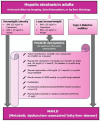Non-Alcoholic Fatty Liver Disease and Extrahepatic Cancers: A Wolf in Sheep's Clothing?
- PMID: 35877216
- PMCID: PMC9325209
- DOI: 10.3390/curroncol29070356
Non-Alcoholic Fatty Liver Disease and Extrahepatic Cancers: A Wolf in Sheep's Clothing?
Abstract
Non-alcoholic fatty liver disease (NAFLD) is now considered the main driver and leading cause of chronic liver disease globally. The umbrella term NAFLD describes a range of liver conditions closely related to insulin resistance, metabolic syndrome, diabetes mellitus, obesity, and dyslipidemia. At the same time, several malignancies, including hepatocellular carcinoma and colorectal cancer, are considered to be common causes of death among patients with NAFLD. At first, our review herein aims to investigate the role of NAFLD in developing colorectal neoplasms and adenomatous polyps based on the current literature. We will also explore the connection and the missing links between NAFLD and extrahepatic cancers. Interestingly, any relationship between NAFLD and extrahepatic malignancies could be attributable to several shared metabolic risk factors. Overall, obesity, insulin resistance, metabolic syndrome, and related disorders may increase the risk of developing cancer. Therefore, early diagnosis of NAFLD is essential for preventing the progression of the disease and avoiding its severe complications. In addition, cancer screening and early detection in these patients may improve survival and reduce any delays in treatment.
Keywords: colorectal adenomas; colorectal cancer; extrahepatic cancers; insulin resistance; metabolic syndrome; non-alcoholic fatty liver disease.
Conflict of interest statement
The authors declare no conflict of interest.
Figures




References
-
- Wong R.J., Aguilar M., Cheung R., Perumpail R.B., Harrison S.A., Younossi Z.M., Ahmed A. Nonalcoholic Steatohepatitis Is the Second Leading Etiology of Liver Disease among Adults Awaiting Liver Transplantation in the United States. Gastroenterology. 2015;148:547–555. doi: 10.1053/j.gastro.2014.11.039. - DOI - PubMed
-
- McCullough A.J. Pathophysiology of Nonalcoholic Steatohepatitis. J. Clin. Gastroenterol. 2006;40:S17–S29. - PubMed
Publication types
MeSH terms
LinkOut - more resources
Full Text Sources
Medical

